When you tell people you’re going to spend some time in a country just off the Persian Gulf, you often get a wide range of reactions. From people telling you it’s dangerous to others trying to persuade you to not go, misconceptions and stereotypes have fueled many people’s desires to steer clear of this part of the world. But when I visited Kuwait in October of 2019, I found a beautiful, peaceful country filled with some of the kindest souls I’ve ever met while traveling. They make the top things to do in Kuwait City even more memorable!

Located at the northeastern corner of the Arabian peninsula, Kuwait has blossomed into a gorgeous, tourist-friendly country in the decades since the Gulf War. Largely influenced by British culture with a massive ex-pat population, this country has large Indian and Egyptian communities. It is also home to the sixth-largest oil reserves in the world. Its currency, the Kuwaiti dinar, is the highest-valued currency on the planet.
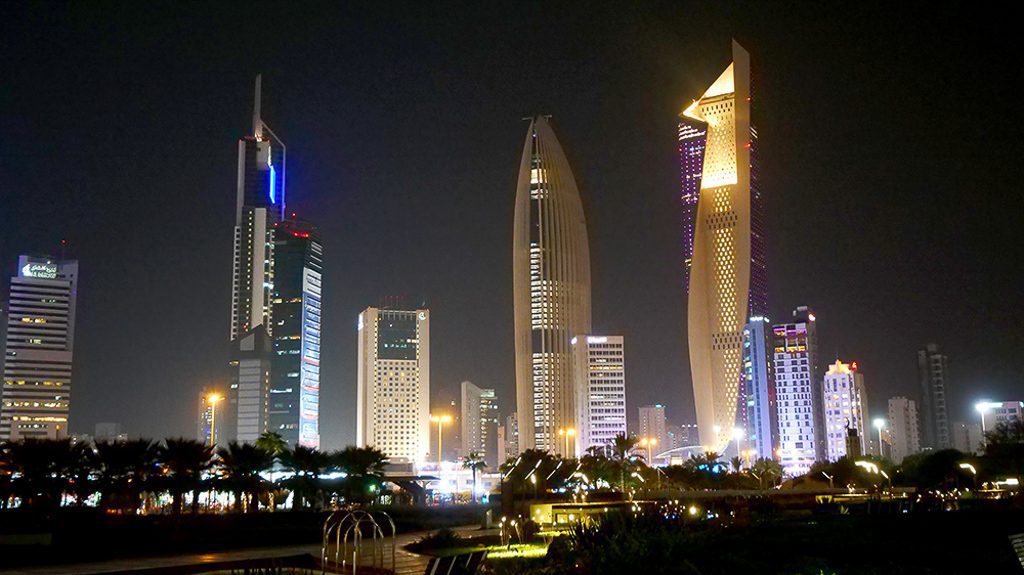
I spent just 48 hours in Kuwait following a ten-day adventure through the country of Armenia. During those two days, I crammed in as many adventures as I could, led by my trusty guide Yousef from Local Tour Kuwait. From mouthwatering Kuwaiti food to breathtaking views overlooking the Gulf to exploring the lanes of the local souk, the time I had there was truly priceless. These are the 18 things to see, do, and eat in Kuwait City, Kuwait.
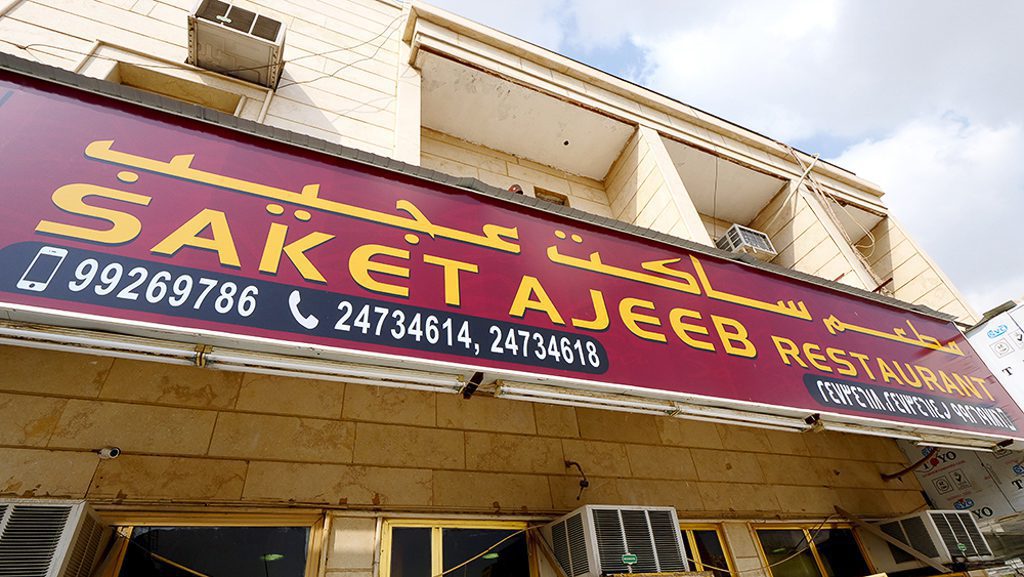
Within hours of touching down in Kuwait City, I had my very first food adventure in the city at Saket Ajeeb Restaurant. The fare at this Arabic-Indian eatery truly blew my mind. As a lover of Indian food, I couldn’t get enough of the cheese samosas that served as an appetizer. They were smaller than typical Indian samosas but had a nice crunch and reminded me of a fried mozzarella stick.
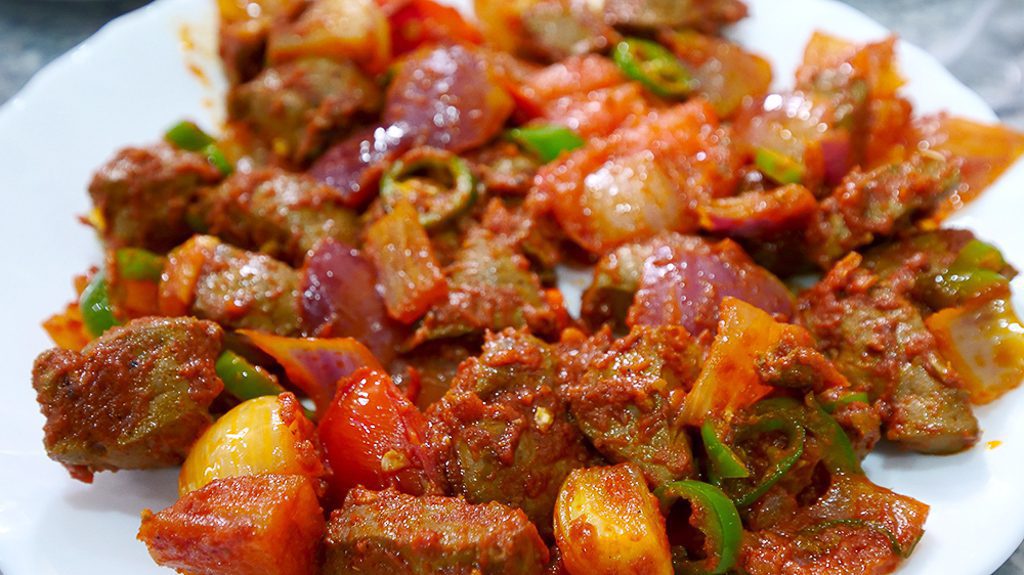
Nearly every meal in Kuwaiti restaurants comes with fresh herbs. They are a great component to add to your main dishes. I recommend trying a flatbread called chapati with a rich, spicy dish containing beef liver, chilies, onions, and tomatoes. There’s also a second beef dish that was more like a spicy and meaty gravy. The chewy chapati, the rich meat, and the refreshing herbs contrast nicely with each other. Together, they make for a complex and satisfying bite!

Finish your meal with a tea called chai halib. Like Indian chai, chai halib is silky and creamy due to the addition of milk. But it’s also different from Indian chai because it doesn’t contain ginger or cardamom. That said, it’s still incredibly tasty without the spices. All in all, this meal can easily feed two people. It only costs 3.5 Kuwaiti dinar (KD), or roughly $13-14 USD.
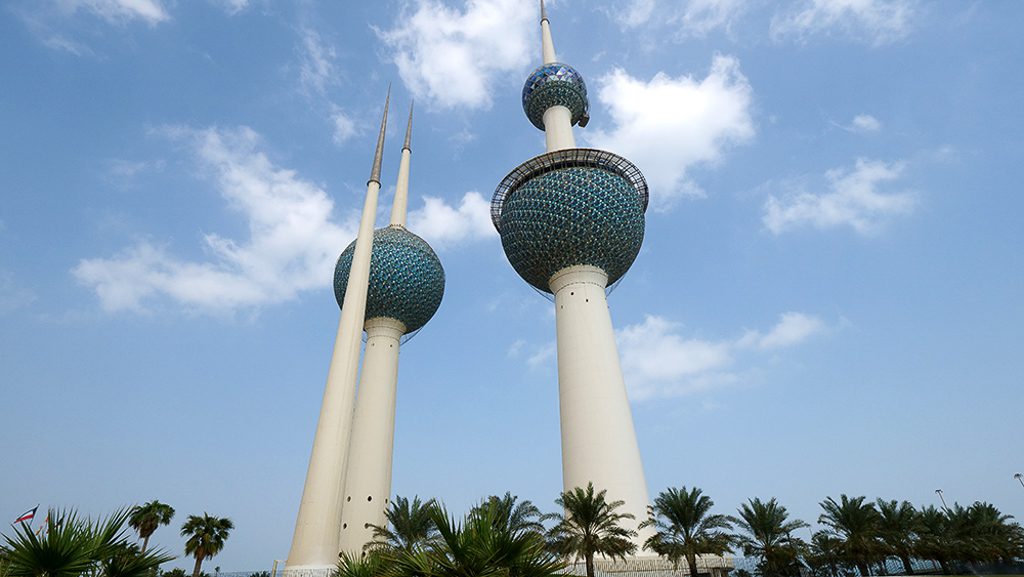
When I visit a new country, I like to see it from different perspectives. For me, that usually means experiencing it on the ground and viewing it from above. The best place to get a bird’s eye view of Kuwait City is the Viewing Sphere at Kuwait Towers. These three tall, thin towers opened in 1979 as part of the Kuwait Water Towers system. They were once the tallest structures in the Middle East, and one of them is home to a café and the Horizon Restaurant.

But the main attraction here is the Viewing Sphere, Kuwait’s only observation deck. Rising 120 meters, or roughly 394 feet, off the ground, the globe-shaped Viewing Sphere boasts stunning views of the Arabian Gulf, the public beaches along the coast, and Kuwait City itself. It only takes a quick elevator ride to reach the Viewing Sphere.
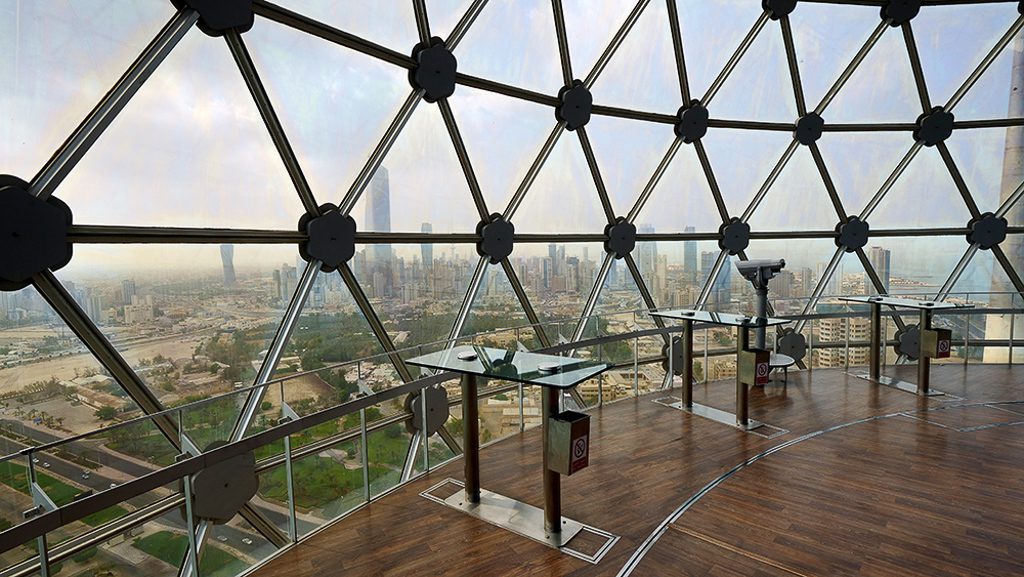
The Viewing Sphere consists of two levels. The first of the two offers limited views, but the second makes up the top half of the windowed globe and offers a much fuller look at your surroundings. They’re the best views in all of Kuwait! Best of all, the second level slowly revolves, so you don’t even have to move to get a 360-degree views. It’s an amazing thing to do in Kuwait City and only costs 3 KD, or about $13 USD.

While Kuwait has come a long way since the nightmarish days of the Gulf War, reminders of that horrific time in the country’s history still stand today. One of the most well-known is Al-Qurain Martyrs Museum. This museum, roughly 20-30 minutes outside the city in Al-Qurain, was once a private residence and headquarters of the Al-Messilah group. This group had vowed to protect their country during and after the Iraqis invaded Kuwait in early August of 1990.

Nineteen members of the Al-Messilah group were inside their headquarters when Saddam Hussein’s forces attacked the building on February 24, 1991. The Iraqis shot at the building using tanks over the next ten hours. By the next morning, the gunfire had ripped gaping holes in the house’s walls. Only seven Al-Messilah members survived.

When you tour Al-Qurain Martyrs Museum, it’s impossible to miss the bullet holes that pockmark the former home. As you explore, you’ll also see signs marking the locations where important Al-Messilah members died during the fight. There’s also a Russian tank used by the Iraqis outside the front door. It’s a sobering reminder of the horrors the Kuwaiti people faced during the war. It’s also one of the most important things to do near Kuwaiti City.

For men traveling through Kuwait, one of the most fashionable ways to immerse yourself in the local culture is to don a gutra. Also known as a keffiyeh, it is a square cotton scarf that can be wrapped around your head or draped so that it falls onto your shoulders. These traditional head coverings help protect against the sun, sand, and dust in arid nations throughout the Middle East.
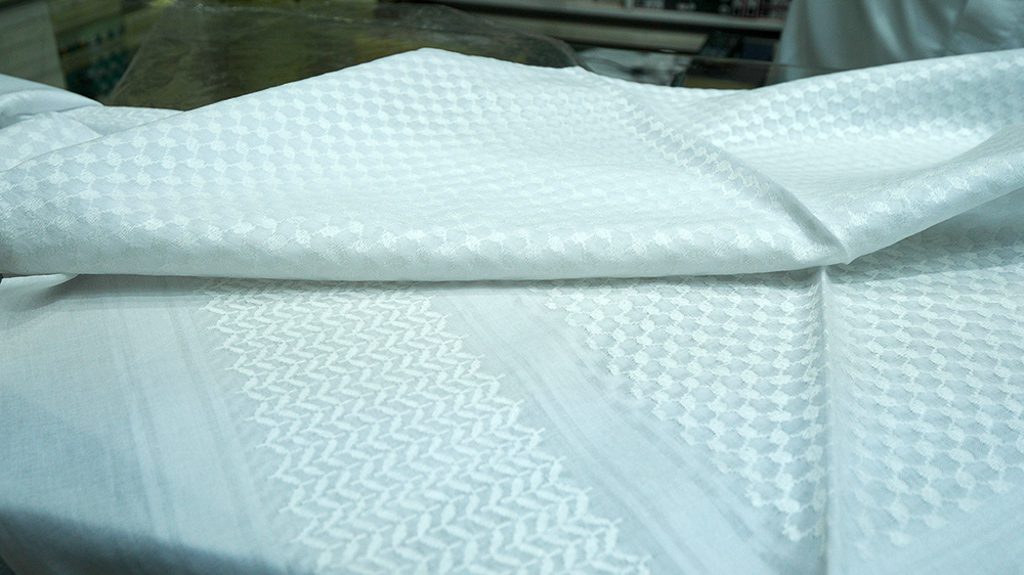
When I traveled through Jordan several years ago, I bought a red-and-white checkered gutra. But in the states off the Persian Gulf, like Kuwait and Bahrain, solid white gutras are the most popular. I bought one for 3 KD, or about $13 USD, and the shop owner wrapped it around my head for me. It was incredibly comfortable and allowed my head to breathe and cool off!

Something that has been synonymous with the Middle East for years is oil. In Kuwait City, there’s actually a museum where you can learn all about the country’s oil history. Visiting this awesome complex, the Kuwait Oil Company Ahmad Al-Jaber Oil & Gas Exhibition, is easily one of the top things to do in Kuwait City, Kuwait!
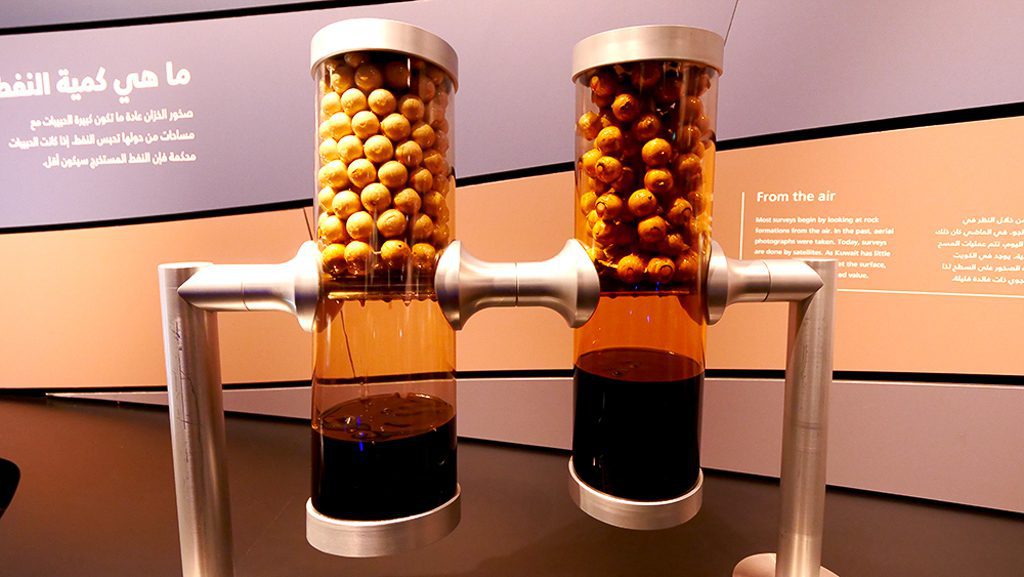
If you’re interested in learning more about the history of Kuwait, this free museum is a real treat. You’ll be provided with a free tour guide, who will take you through the eight galleries on an hour-long tour. From the largest LED screen in the Middle East just inside the entrance to the interactive displays, you’ll learn how oil forms, how and where it was first found in Kuwait, how much the Kuwait Oil Company produces per second, and much more!
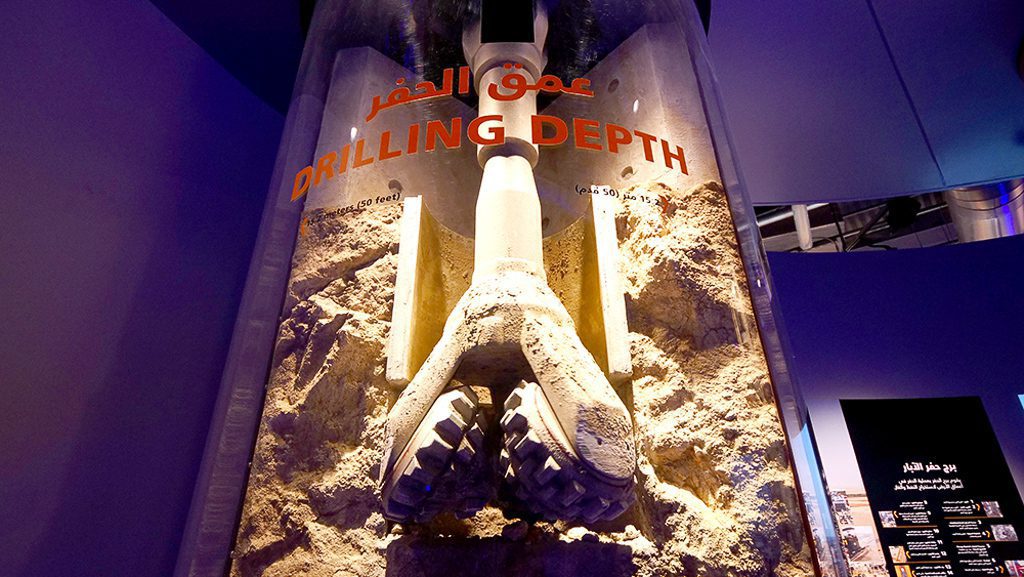
You can also watch a documentary that explains how countries around the world came together after Saddam Hussein’s troops burned 600 Kuwaiti oil wells. It was an enlightening, intense, and inspiring look at the 9-month process to put them out. I highly recommend it when you visit!

Speaking of the Gulf War, one of the most beautiful areas of the city was dedicated to the people who lost their lives during the conflict. Al Shaheed Park is a large, peaceful, well-kept park that will serve as a green belt that will wrap around Kuwait City once it’s finished being built. Visiting it was one of my favorite things to do in Kuwait City, Kuwait.
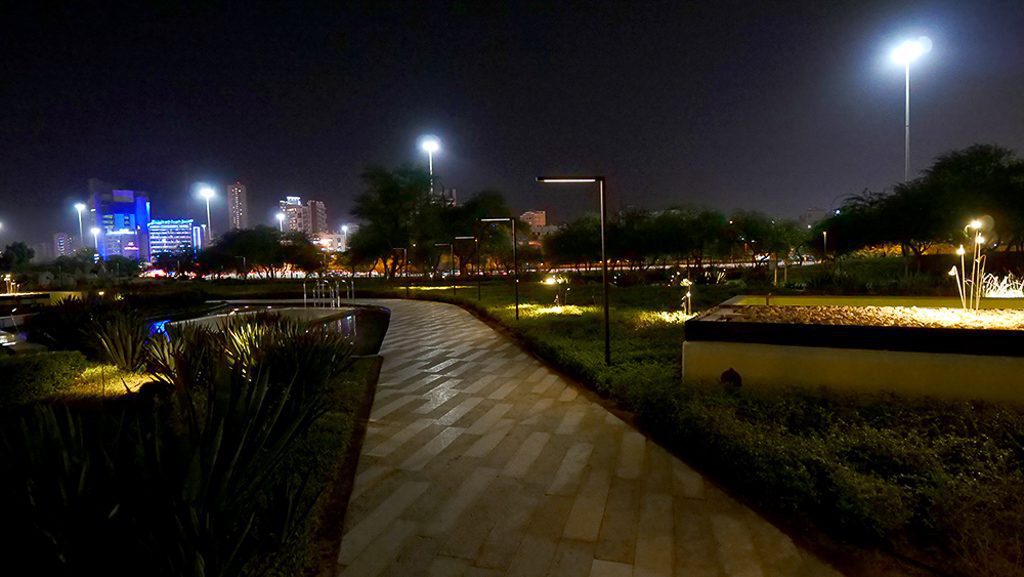
I visited Al Shaheed Park on my first night in Kuwait and loved the serene atmosphere. You’ll find fountains and ponds there, as well as lots of park benches. Don’t be surprised if you see quite a few people jogging, walking, and working out among the green spaces. The Kuwait City skyline is visible from the park, and if you get hungry, there are plenty of restaurants and cafés nearby.
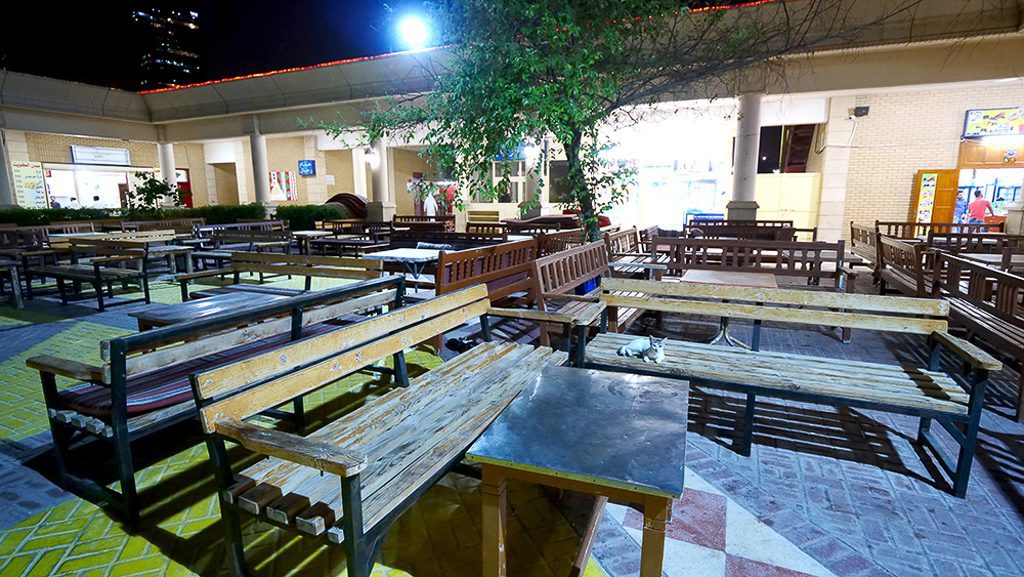
One of my favorite things to do in Kuwait City is eat one of my all-time favorite foods, kebabs. There are few kebab places in the city better than Traditional Café Shemaimry, an open-air café and teahouse near the shores of Kuwait Bay. The original café was built in 1979 under a different name and suffered a horrific bomb blast in 1985. The explosion killed the owner, Shemaimry, and the restaurant was rebuilt and renamed in his honor.
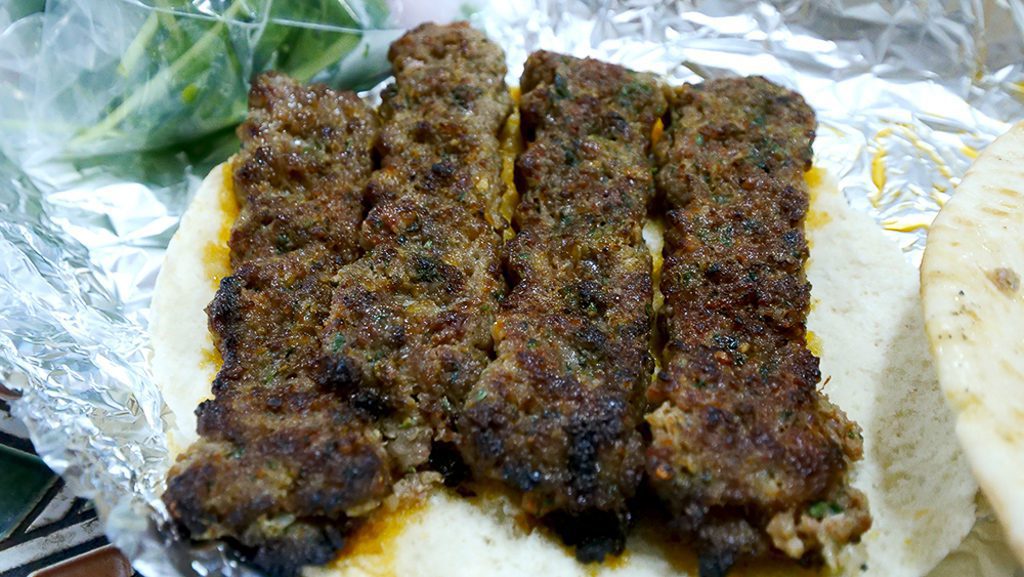
Today, Traditional Café Shemaimry is a popular place for locals to get together and discuss hot-button issues like politics. It’s also home to some of the juiciest and most tender kebabs in Kuwait! My friend and guide Yousef and I ordered a plate of four kebabs and a fantastic dish that consisted of bread stuffed with mincemeat, onions, herbs, and spices for 2 KD.
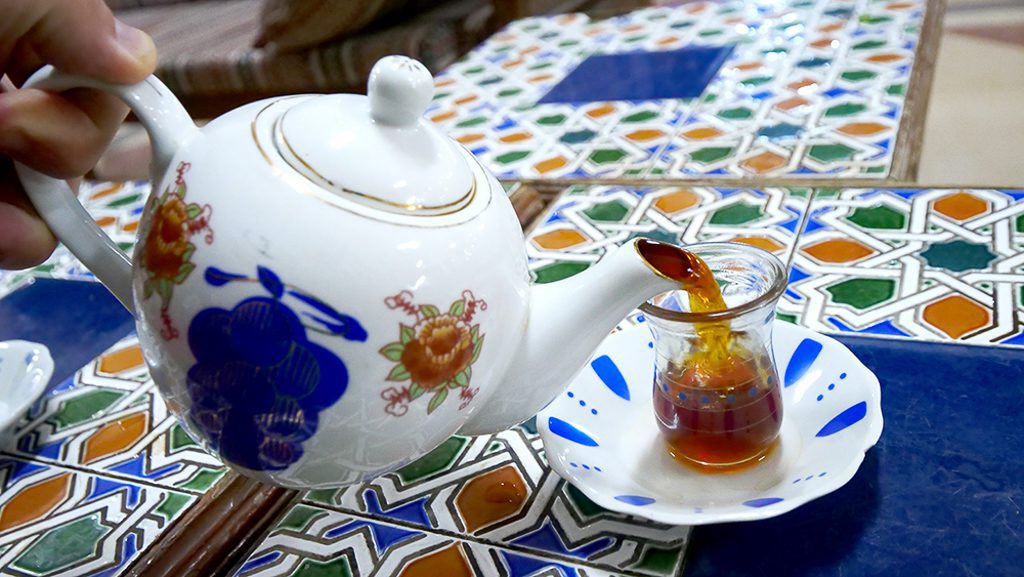
As was the case with every Kuwaiti meal I had, the order came with a plate of fresh, crunchy herbs. They pair nicely with the crispy, smoky stuffed bread and the kebabs, which had me salivating after a single whiff. Let the juices from the kebabs soak into the bread for a major flavor explosion in your mouth. Finish off your meal with some black tea with no sugar. Just eat fast, as your dinner may also attract the attention of the local stray cats!
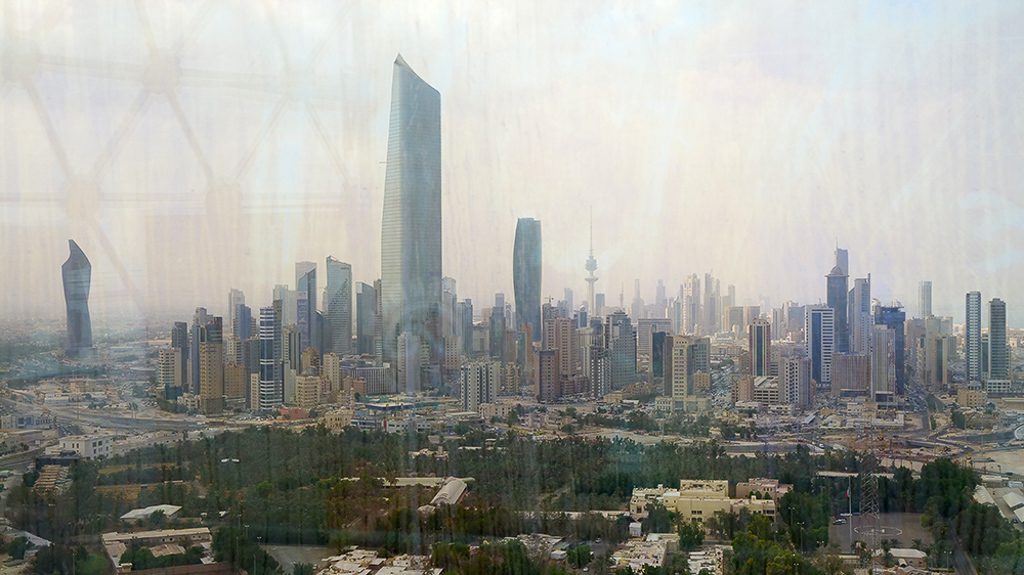
On my first night in Kuwait, I continued to cram as many quick activities into my itinerary as I could. I only had forty-eight hours to explore, so I knew I would miss out on a lot. My final activity of the day was a quick visit to Al Hamra Tower, the tallest tower in Kuwait!

Located in the middle of the city’s downtown area, this 414-meter tower is the tallest carved concrete skyscraper in the world. This tower is a work of art and took six years to build between 2005 and 2011! It’s quite beautiful, and on the night I visited, it was lit up with purple and yellow lights. Just outside the tower itself are a giant LED screen and some fountains.

Inside, the tower boasts a 24-meter-high lobby with no columns, office space, and even a shopping mall. Check out the interior if you have the time. It’s one of the best things to see and do in Kuwait City, Kuwait. But if you’re on a tight schedule, you just admire it from the outside like I did.
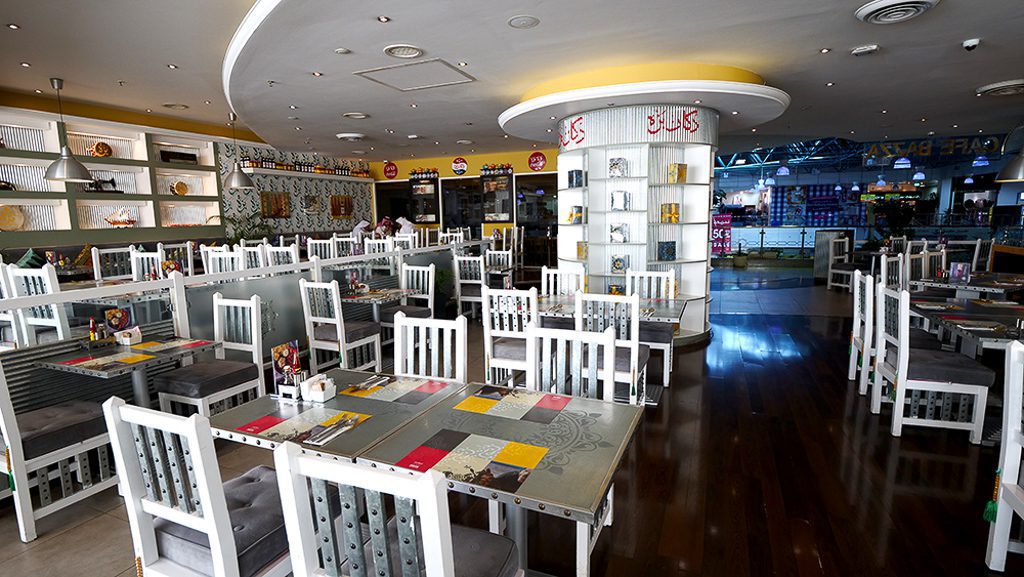
When I’m not traveling, I often skip breakfast and fast until about noon, but when I’m in another country, I try to get as many tastes of the local cuisine as I can. That was certainly the case on the morning of my second day in Kuwait, when my guide Yousef took me to Café Bazza for a traditional Kuwaiti breakfast.
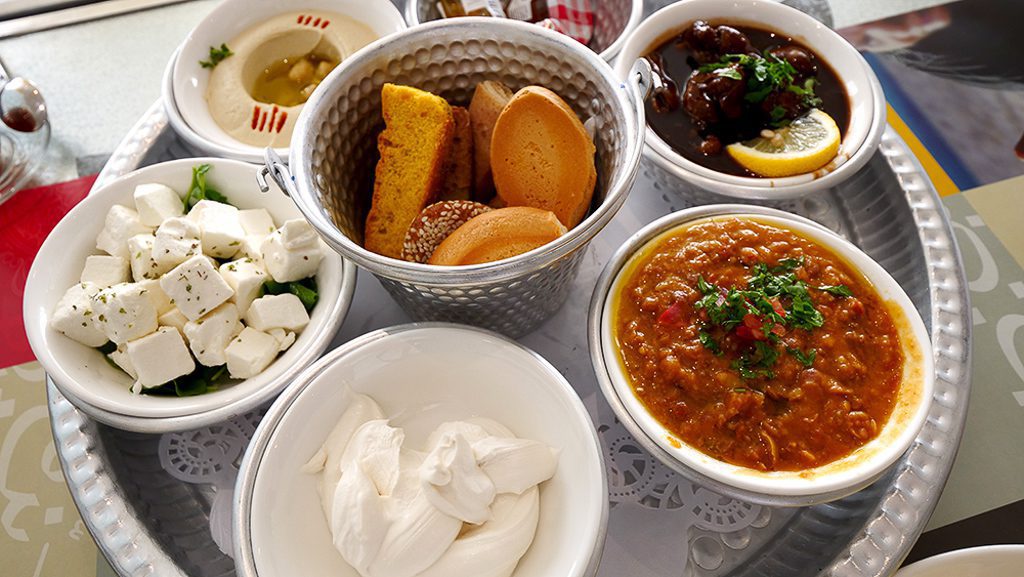
Café Bazza is a chain of restaurants that you can find in Kuwait and Dubai. This location had an almost diner-like feel and was located inside a shopping mall. You place your order on their iPads. I recommend the Dasman Combo, a roughly $25 USD breakfast bonanza that consists of dishes like an omelet, feta cheese, tanoor bread, darabeel, baqsam, Kuwaiti cakes, chicken liver, foul, hummus, honey, cream, black tea, fresh herbs, and jam.
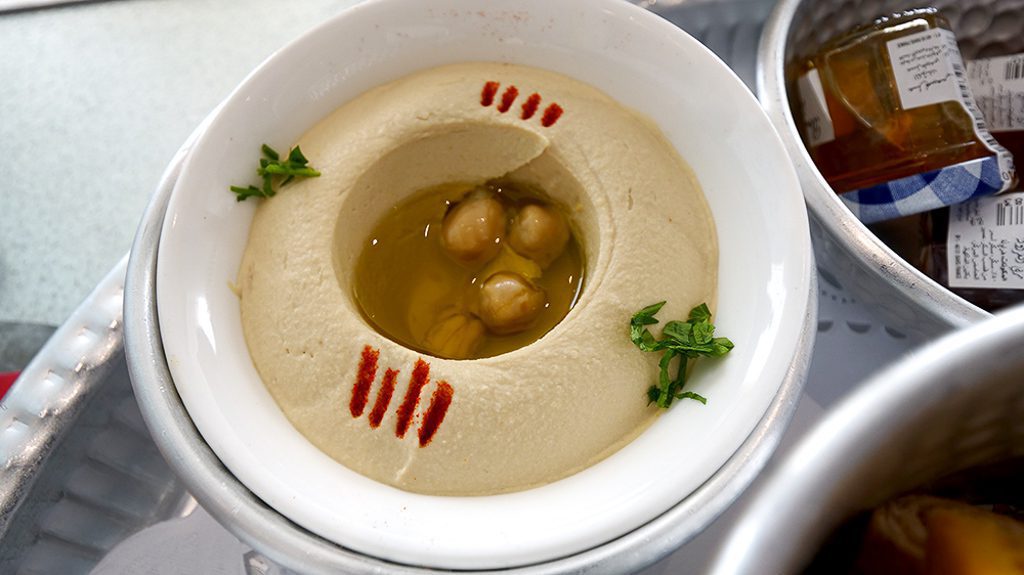
The omelet, which comes wrapped in tanoor bread, was a major (and filling) highlight of this meal. I couldn’t get enough of the fluffy bread and cheesy eggs. The foul—a fantastic, thick mixture of different beans and tomatoes—was perfect with the bread.

I also fell in love with the chicken livers, which were covered in a goopy, glazy sauce that tasted similar to balsamic vinegar. The feta was nice and fresh, and the sweet cake was heavenly with honey drizzled on top! This meal is easily one of the top things to do and eat in Kuwait City, Kuwait!
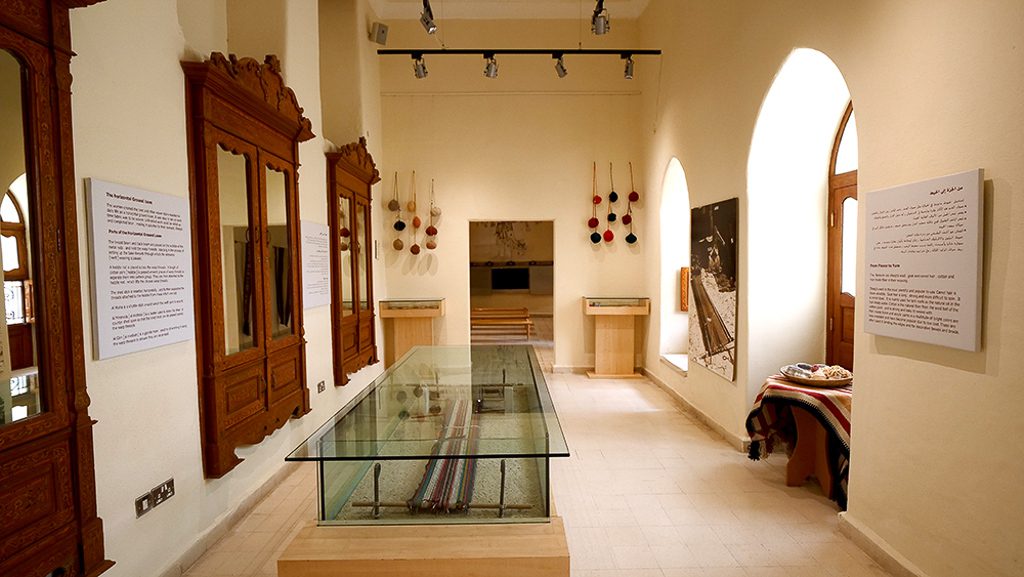
The food in Kuwait is excellent, without a doubt, but don’t focus on it so much that you forget to dive into the local culture. One of the best places to do just that is the Sadu House. This museum and cultural center aims to promote Kuwaiti textile arts and other related skills.
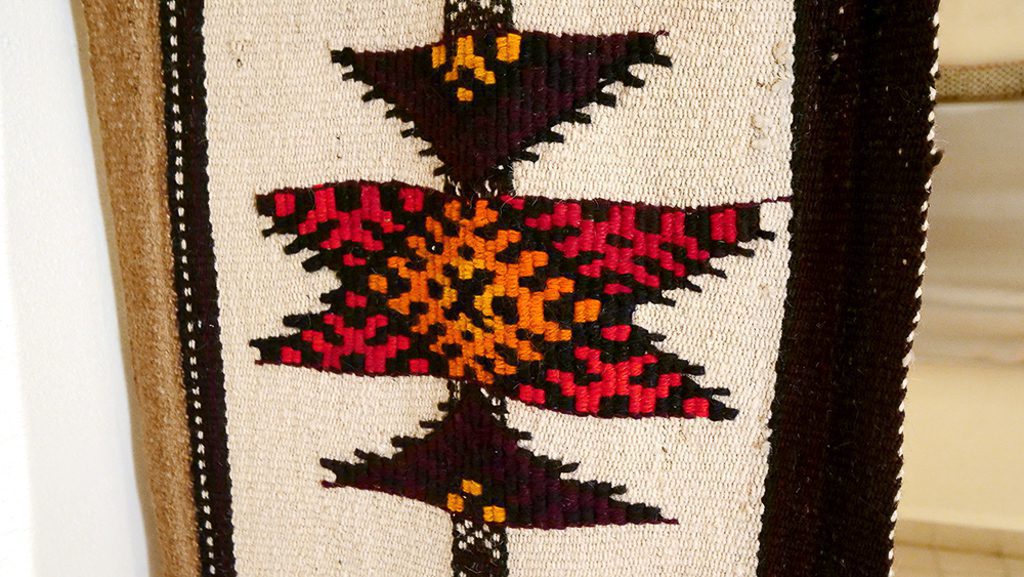
Before you head inside, be sure to check out the gorgeous Kuwaiti ships outside the museum. The largest one was used to ship Kuwaiti pearls to India before they struck oil in the country.
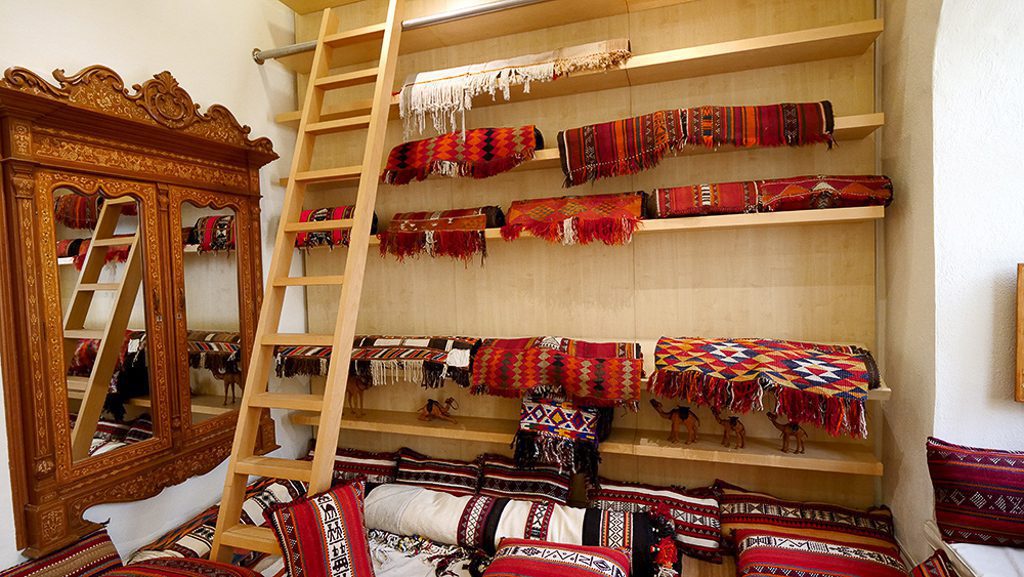
Inside the Sadu House, you’ll learn about the Kuwaiti textile known as Al Sadu. This beautiful creation looks similar to a long, woven rug, but it’s often used as a room or a tent divider. They’re woven from materials like sheep and goat hair that has been dyed and turned into differently-colored yarns. The Al Sadu contain intricate Sadu patterns, which tell a story. The patterns were also used by the weavers to communicate with each other because they couldn’t read or write.
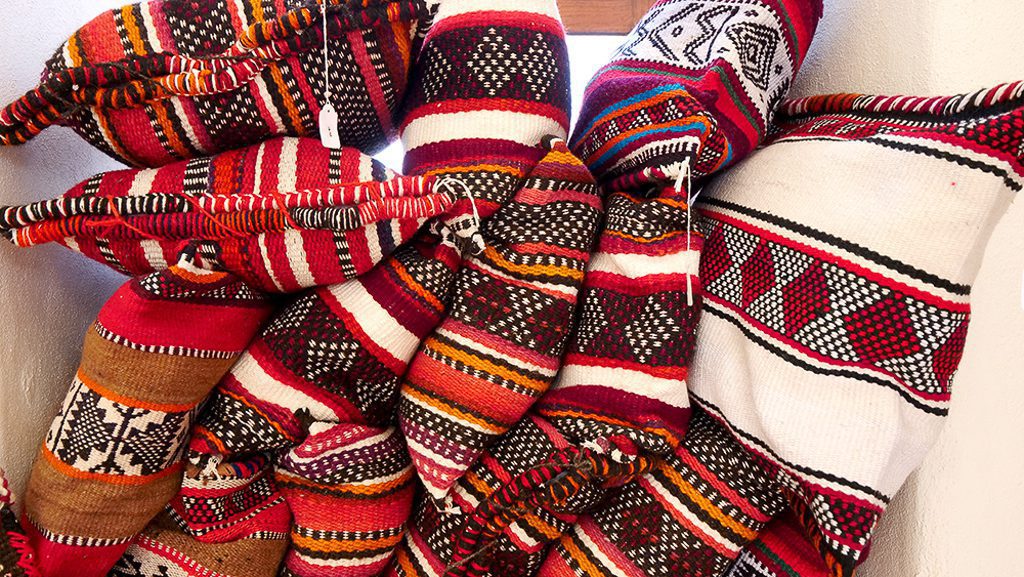
Elsewhere at Sadu House, you’ll find urban weaving, which is basically formalwear made mostly of silk. One of the prettiest creations I saw was a colorful seat, covered by a tent, that’s meant to be placed on a camel for women to ride on it. Road!
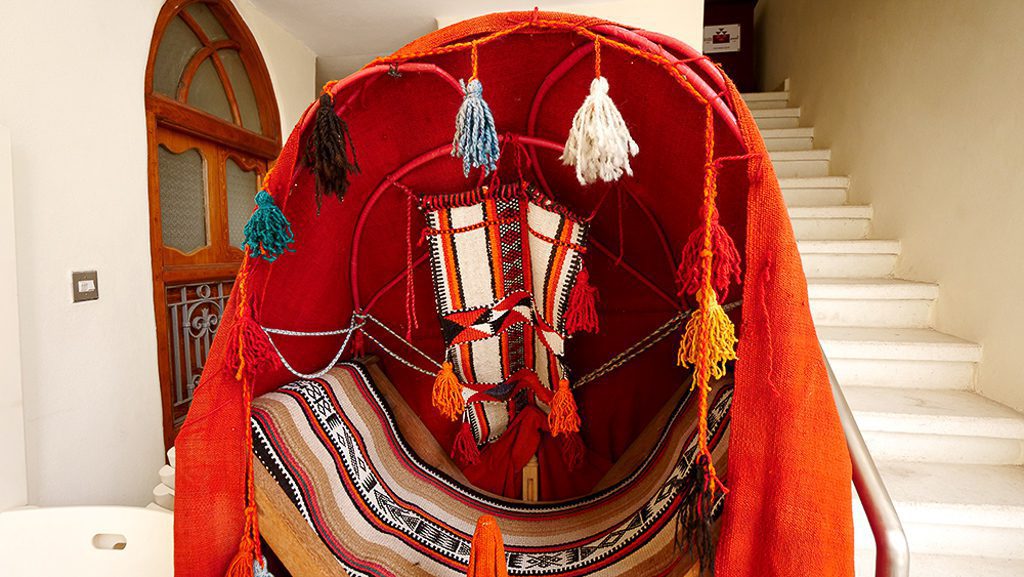
There is also an on-site gift shop where you can buy woven produces like table runners, chairs, pillows, children’s shoes, and more. Everything there is more on the pricier side, but you simply cannot beat the quality. Support the local crafts scene and buy a unique souvenir for yourself!

As much as I like Kuwaiti tea, I have to say, I absolutely love the coffee there. Even if you’re not a big coffee drinker, having some is one of the best things to do in Kuwait City, Kuwait. For a taste of some of the city’s best coffee, head over to Jumo Coffee, which is right next door to Sadu House.
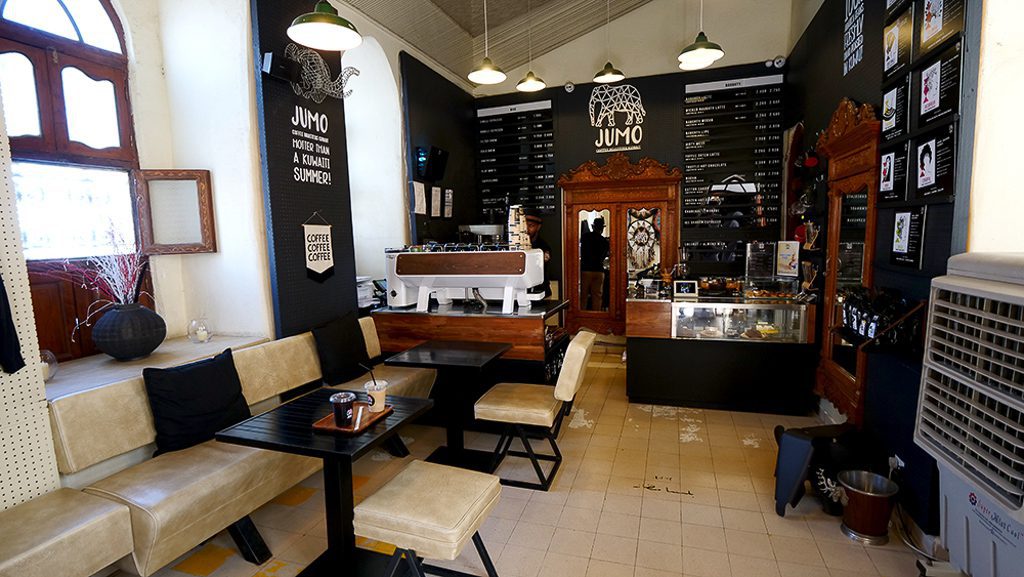
Kuwait is a dry state, meaning there is no alcohol allowed within its borders. Because of that, coffee is the main drink that locals bond over and arrange get-togethers around. Drinking coffee here is a real social activity!

I recommend trying Jumo Coffee’s cold brew. This special blend is downright magical and is brewed for eight hours. It’s so good that it doesn’t need sugar at all. I’m a staunch believer that good coffee never needs sugar in it. Visit Jumo Coffee during your time in Kuwait and try out their sugar-less coffee. You’ll thank me later!
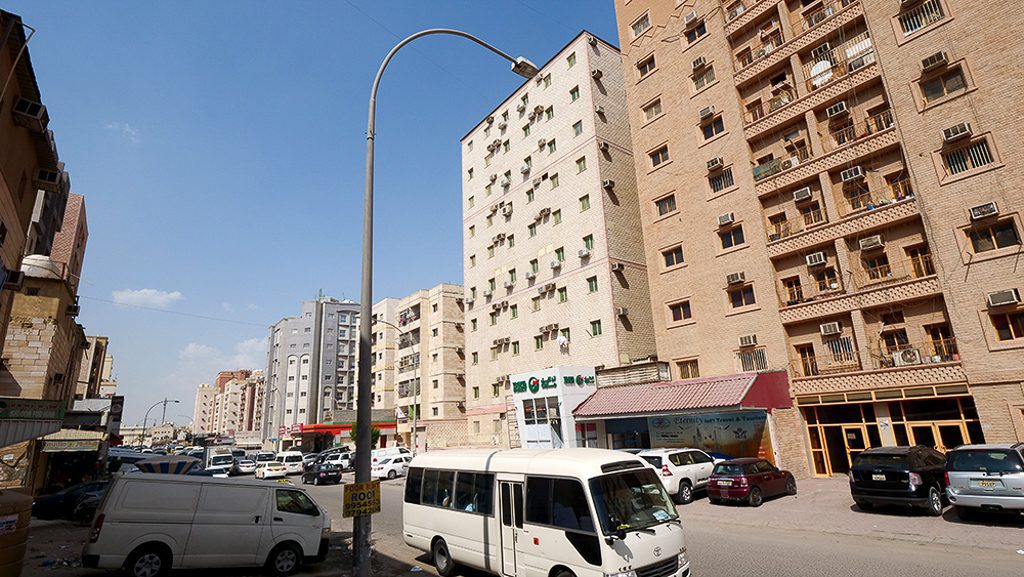
A whopping 70% of Kuwait’s population is made up of ex-pats from other countries, including India, Egypt, Pakistan, Bangladesh, and Syria. One of the best places in the country to experience Kuwait’s diversity is the town of Jleeb Al Shuyoukh. This town, located close to Kuwait International Airport, is home to over half a million Indian ex-pats alone. The influences from India are visible at every turn.
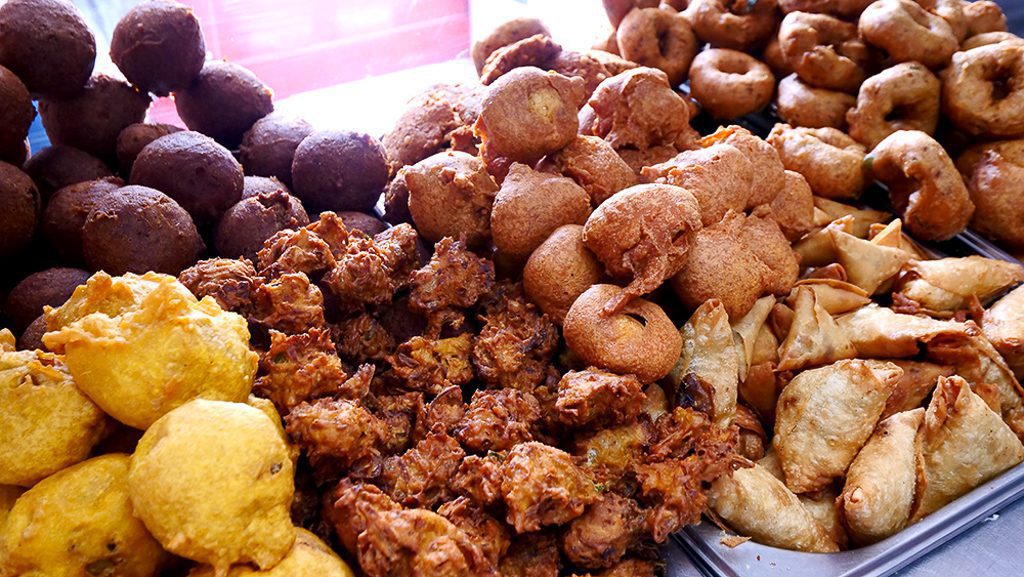
There are lots of Indian bakeries and restaurants in the town, including those selling Keralian and Mughlai cuisine. I felt like I was back in India as I rode through the town! To really get a taste of India, stop by one of the shops or restaurants to get something to eat. It was ridiculously hot on the day I visited, so I stopped by Balancia Bakery Sweet and Pastries for a nice, cooling lassi. It only cost me half a KD, or roughly $2 USD. Having one is the best things to do in Kuwait City, Kuwait!
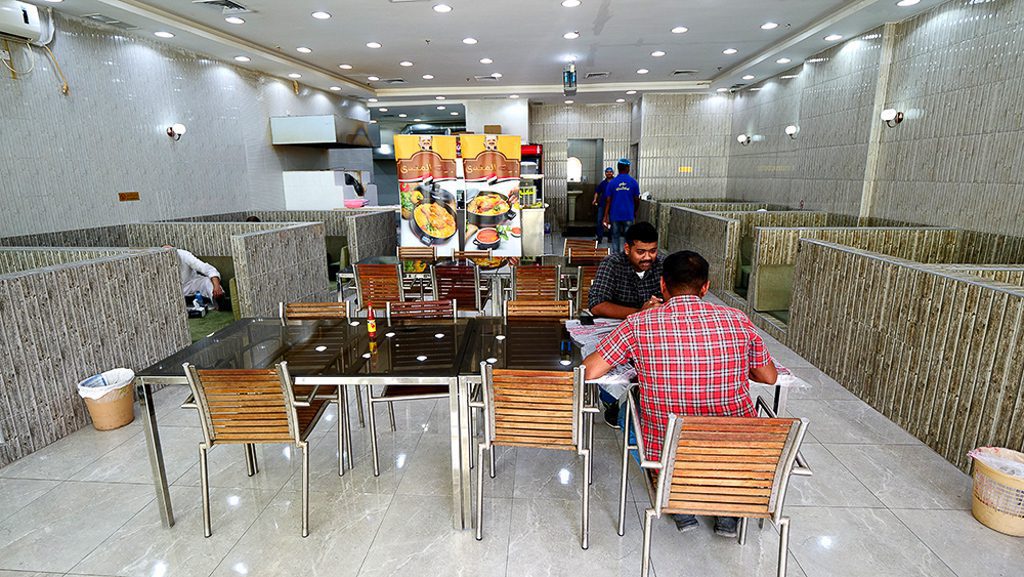
It’s no secret that I love Indian food and dishes that remind me of the Subcontinent. So when I heard that you can try a goat-meat-and-rice dish similar to biryani at Bait Al Mandi Restaurant, I knew I had to check it out. This dish, called Laham Mandi, is made up of basmati rice, crispy onions, and big pieces of tender, flavorful goat meat.
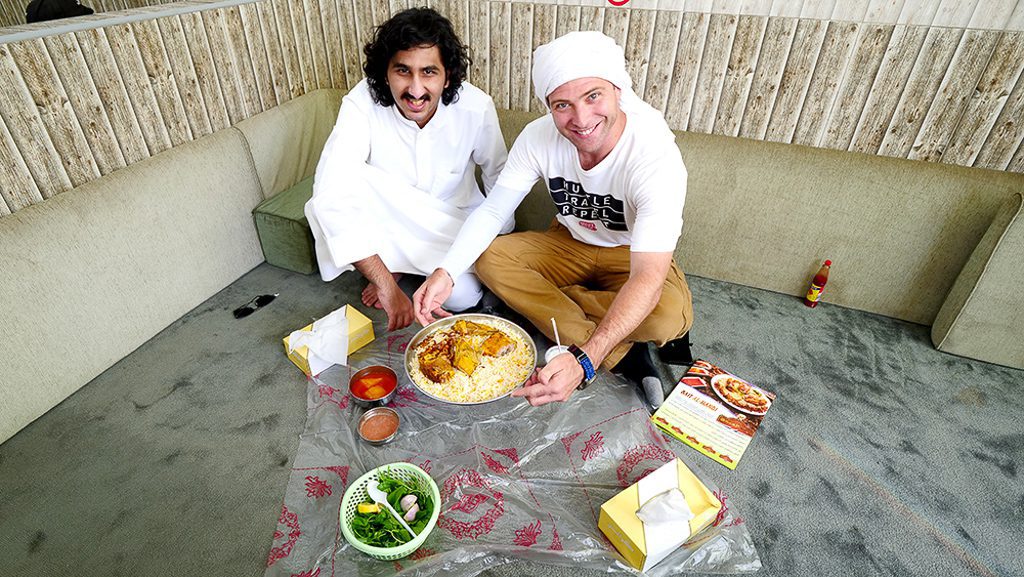
You eat the laham mandi in a private booth of sorts. You take off your shoes before you enter and sit on the floor. The people who work there will put down a plastic sheet to cover the floor, followed by your meal.
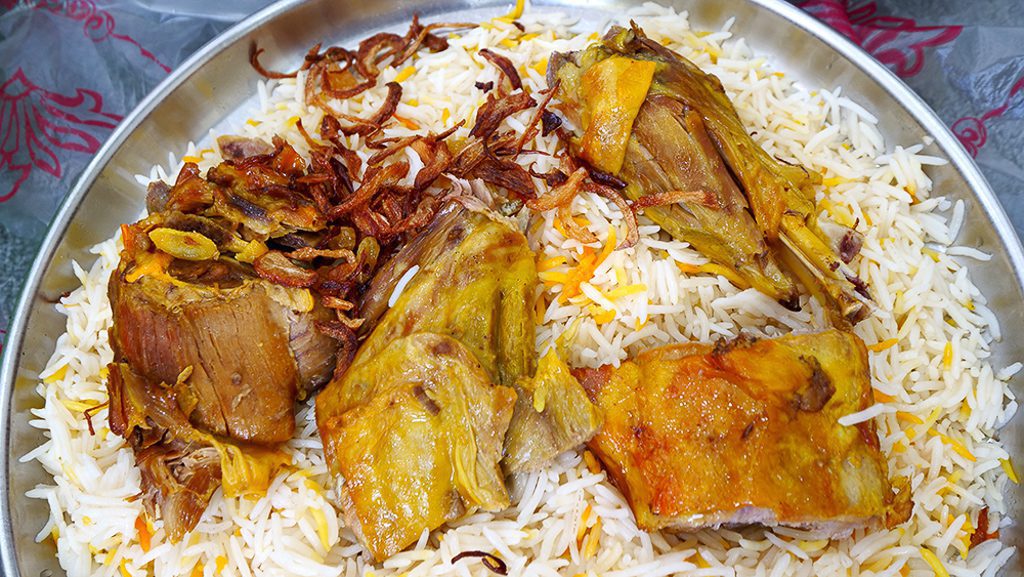
The laham mandi comes with tomatoes and a tomato sauce similar to gazpacho on the side. There are no utensils here, so you eat everything with your hands. In my opinion, eating with your hands gives you a real feel for the food and makes it taste better.
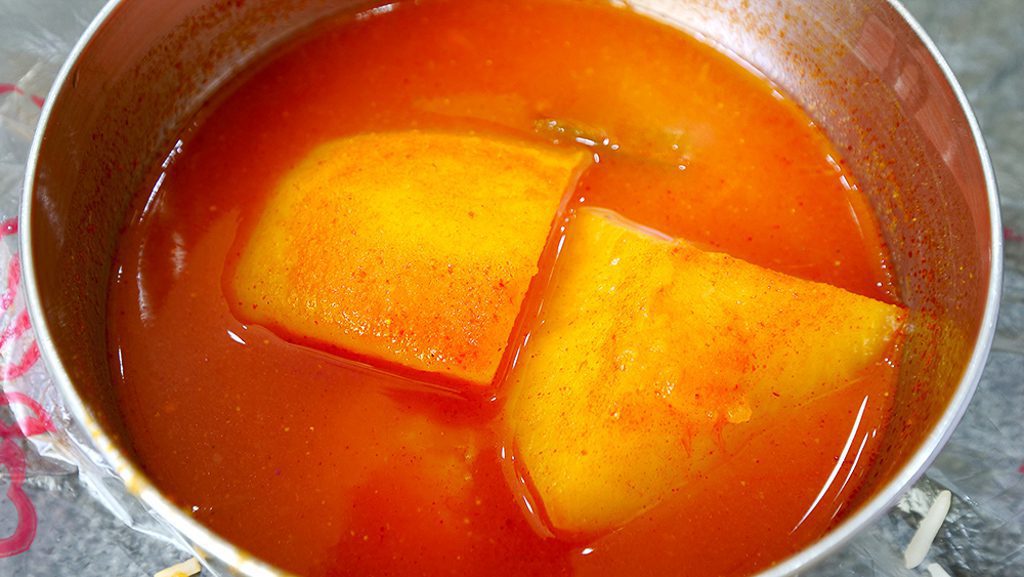
Not that it needed any help tasting better. The goat meat was incredibly fresh, and the onions added a nice, crispy acidity. I loved adding the tomato sauce, which added just the right amount of heat. Finish off your meal with some milk with mint, which had a sour flavor and reminded me of Indian buttermilk! Having this meal was easily one of my favorite things to do in Kuwait City!

Even though Kuwait is a dry state, it doesn’t mean the locals don’t partake in other activities. One of the most popular recreational activities here is to smoke shisha. I’m not a smoker at all, but when you travel, I believe in doing as the locals do. I tried it twice during my visit—once on each of my two days in the country. On my first day, I visited Viking Café, a shisha bar that’s separated into plush, relaxing rooms with couches and televisions. You just take off your shoes, kick back, and relax with your shisha!
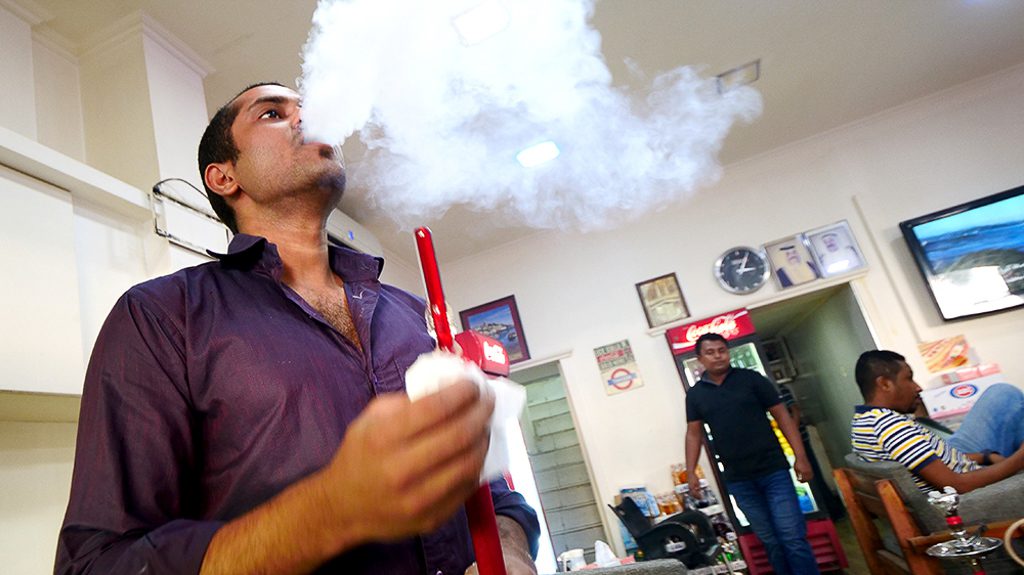
There, they’ll ask you which flavor you want when you walk in. Then, they’ll bring it to you along with enough tips for everyone in your party to use. The shisha there was quite tasty!
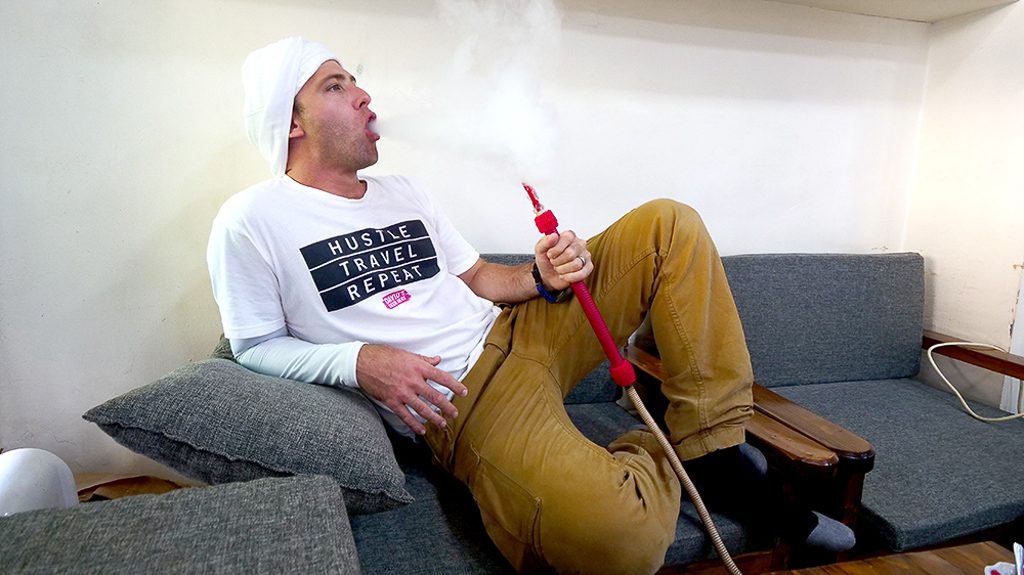
On my second day, I tried a much stronger shisha at a different shisha bar. There, I learned the correct reclining position for enjoying shisha. However, the shisha there was so strong that it made me lightheaded for a while! I actually had to crash for about ten minutes because it made my head spin!

I’ll admit, I’m not much of a shopping mall kind of guy. But when you get the opportunity to visit the largest mall in Kuwait, you take it! If you’re one for retail therapy, head over to The Avenues mall. The second-largest mall in the Middle East and one of the largest in the world, The Avenues opened in 2007 and boasts a whopping 1,100 stores.

The mall’s Grand Avenue is a massive, wide boulevard with a high, transparent roof. It’s meant to give off the feel of an outdoor, open-air shopping street like the Champs-Elysees and Rodeo Drive. In this swanky area, you’ll find the Pristige district, which is home to luxury outlets like Louis Vuitton, Chanel, Prada, Fendi, and Gucci. At the end of Grand Avenue is the 640-meter-long promenade called Grand Plaza, which was inspired by civic squares from around the world.
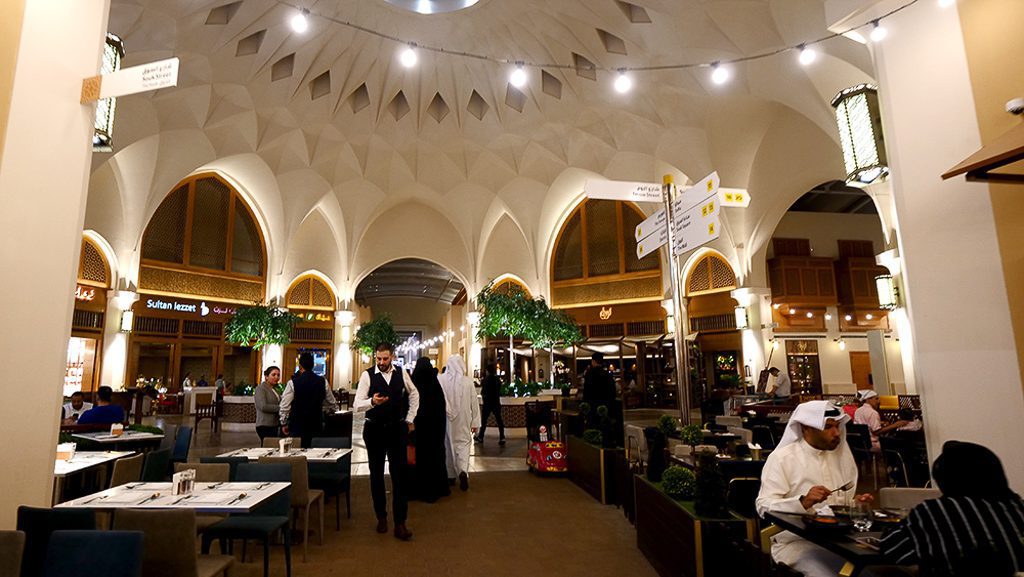
Elsewhere in The Avenues mall, you’ll find the Souk district, meant to give off the feel of traditional Kuwaiti marketplaces, and a white, modern space called the Forum. Those who long for the bright lights of Tokyo and New York should visit the Electra district, and the SoKu district attempts to mimic the bohemian feel of New York’s SoHo area. It’s a cool place to browse and shop, and is easily one of the top things to do in Kuwait City!

High on many lists of the top things to do in Kuwait City is visiting the Grand Mosque. This massive, 20,000-square-foot house of worship was built between 1979 and 1986. The entire complex spans 45,000 square meters and boasts teak wood doors and 144 windows.
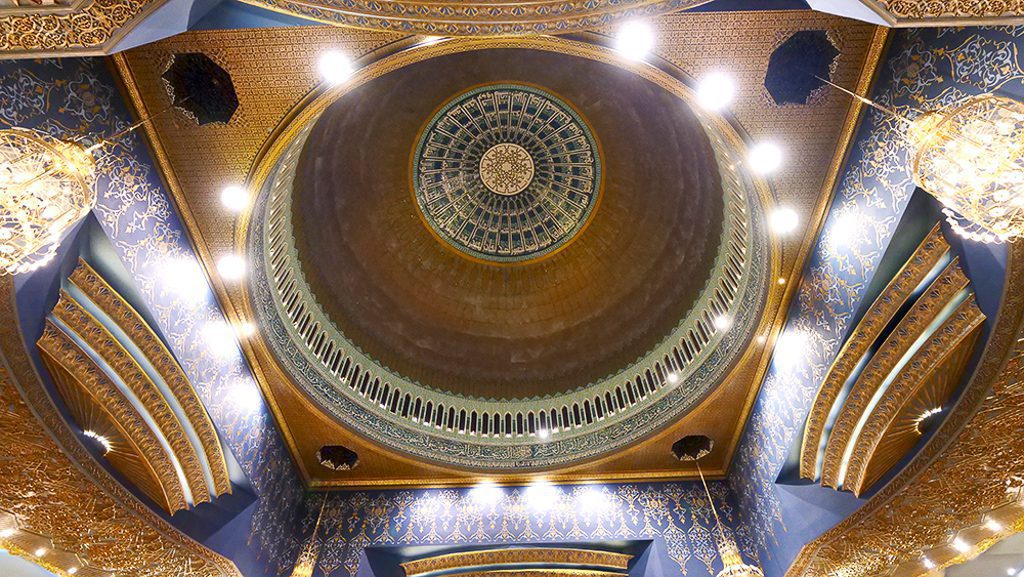
As with any mosque, you must take your shoes off before you go inside. You can take a free tour of the mosque every half hour from Sunday through Thursday between 5 p.m. and 7 p.m. The short but informative tour will allow you to marvel at the intricate architecture and craftsmanship on display inside. Take a good look at the Moroccan mosaics and gypsum around the doors, the stained glass windows from France, the Egyptian carpets, the German chandeliers. The walls are even covered in Italian marble!

On your tour, you’ll also visit the main prayer hall, which can fit up to 50,000 people at a time. There’s a smaller women’s hall that men are forbidden to enter, which holds 500 worshippers. Don’t miss the opportunity to head up to the pulpit, where the imam gives a speech every Friday before the prayer. The views of the entire hall from the pulpit are spectacular!
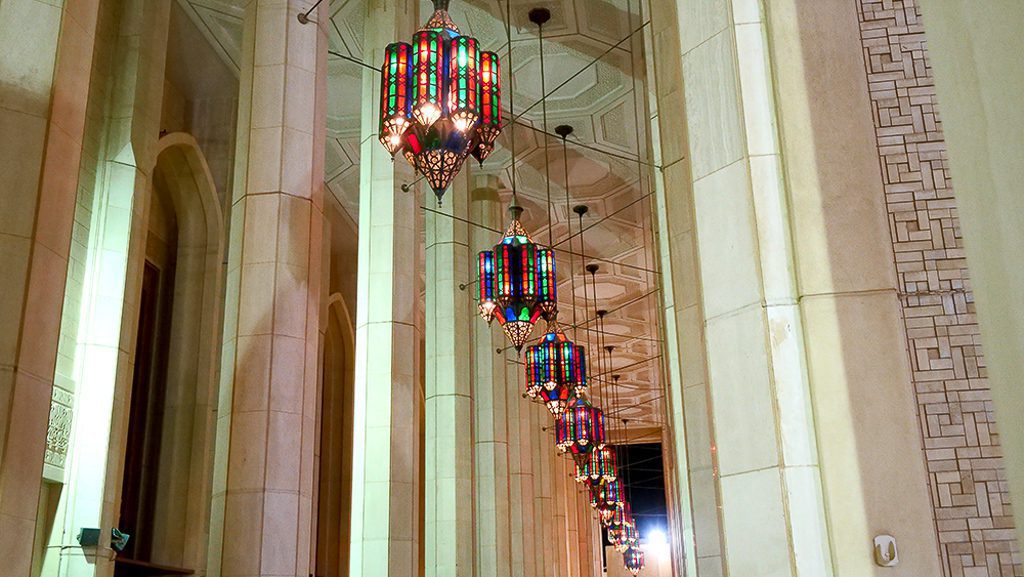
My tour guide, Aziz, also showed me an incredible, 30-year-old recreation of a 1,400-year-old religious book from Turkey. Even though it’s a replica, it is absolutely gorgeous and give off the feel of an important, ancient manuscript. It’s a must-see when you visit the Grand Mosque!
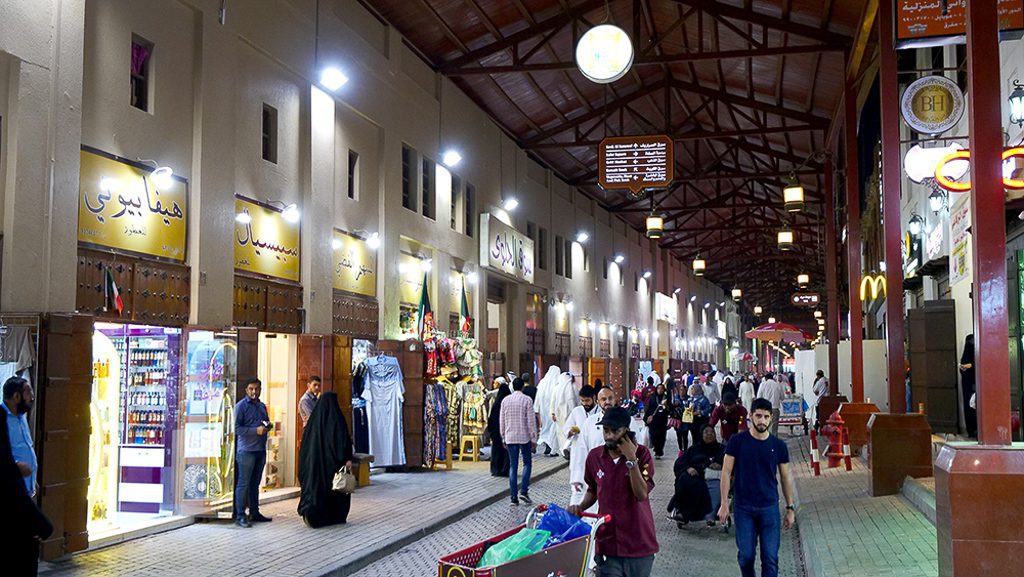
One of the most popular things to see and do in Middle Eastern cities is to visit the local souk, or Arab market. The same is the case in Kuwait City, where you’ll find Souk Al Mubarakiya, one of the oldest markets in the Gulf region. This incredible souk is over 200 years old and is a wonderful and vibrant collection of interesting shops and dynamic aromas and flavors!

During my short time there, I visited a fantastic shop that sells strings of beads that look similar to Christian rosaries. I bought a golden one for 2 KD, or about $6 USD. They’re quite beautiful and make a unique souvenir! If you’re into colognes and perfumes, you can find shops selling both high-end and affordable floral scents.
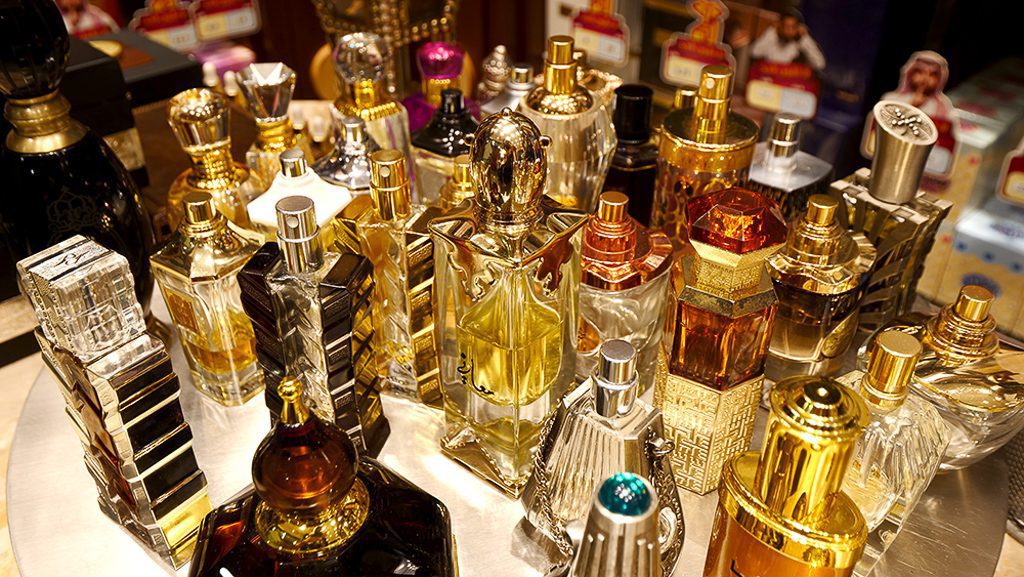
Don’t miss the produce area, where you’ll find vendors selling lots of local fruits and vegetables, including one of my favorites, dates. They’re super fresh and incredibly sweet!
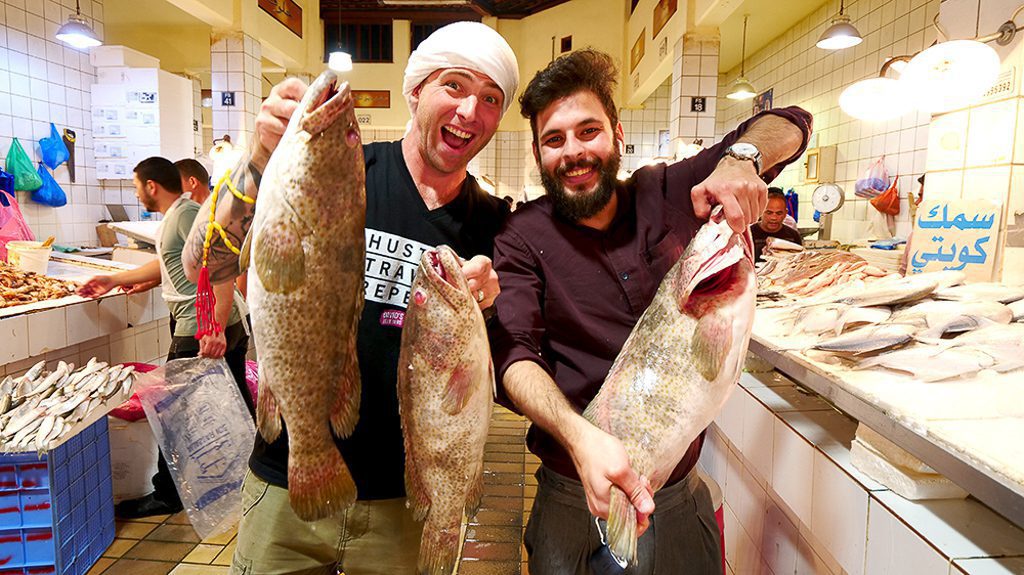
But my favorite areas of Souk Al Mubarakiya are the fish market and the restaurant row right behind it. In the market, the strong smell of fresh seafood will waft over you as you pass vendors selling everything from fresh Kuwaiti fish to shrimp to crab. I recommend buying a fish there and then taking it to the restaurant row for them to cook!
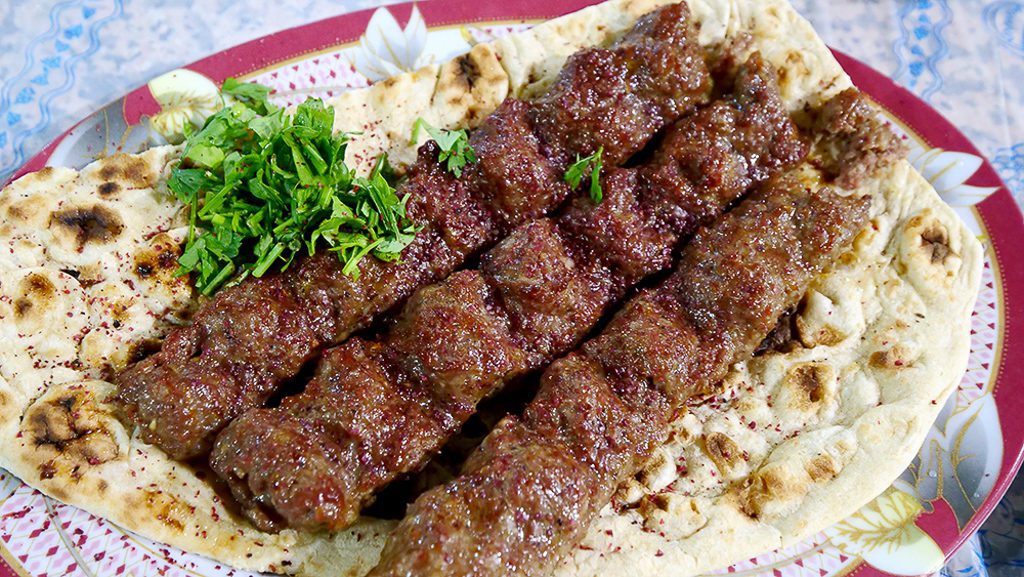
There are tons of other things you can enjoy with your fish in the souk’s restaurant row. I checked out the kitchens and saw cooks frying tasty-looking shrimp dishes, firing up juicy kebabs, and phenomenal-looking Irani biryani. I went with some tender and smoky beef kebabs, bread, and herbs, which was like Kuwaiti surf and turf with the creamy, buttery fish. Complete your meal with some minty tea on the side!

If you decide to visit Souk Al Mubarakiya in the evening, I suggest getting there early, around 7 p.m. That way, you can eat around 8 and still have a few hours to explore, meet the friendly locals, and browse before the shops start closing up around 11:30. When the local stray cats come out to dine on the scraps on the souk floor, you know it’s time to leave!
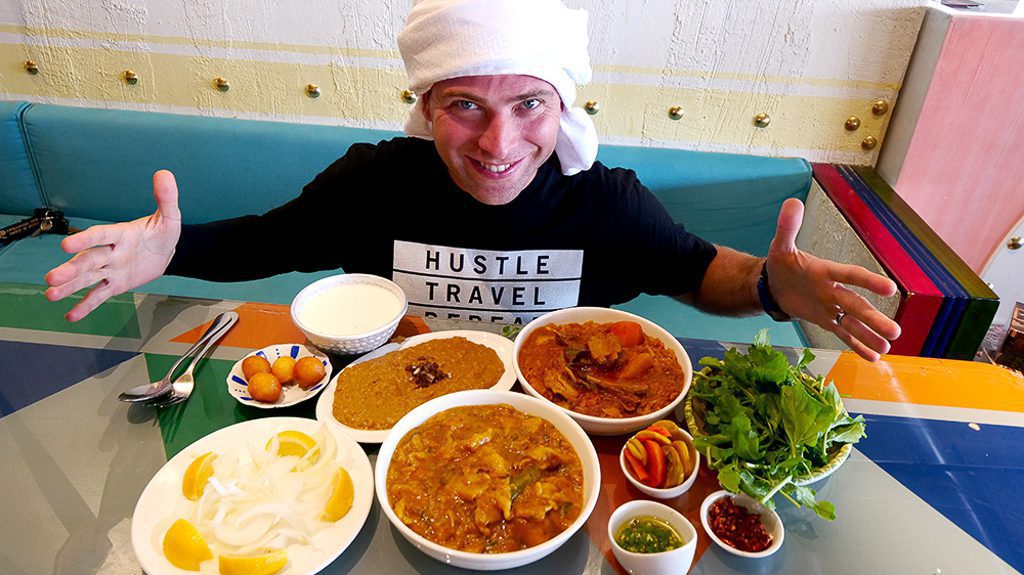
When you visit the town of Aswaq al Qurain, I suggest stopping by Free Swaileh for a delicious, traditional Kuwaiti lunch. It’s one of the top things to do near Kuwait City. Start off with with some Kuwaiti coffee, which your waiter will sling and pour in a pretty fancy and cool way. This variety was a rich, yellowish color and was very creamy despite the fact that it didn’t contain any milk! Enjoy it with a sweet dough ball before your feast comes.

I recommend going all out with the traditional Kuwaiti fare. Try some jareesh, which is a creamy, porridge-like dish made of minced lamb and lentils. Have it with some Iranian bread! I also loved the mutton, which was super fatty and served in a creamy sauce with peppers and carrots. It is every bit as flavorful as it sounds! Add some chilies for a nice kick of heat.
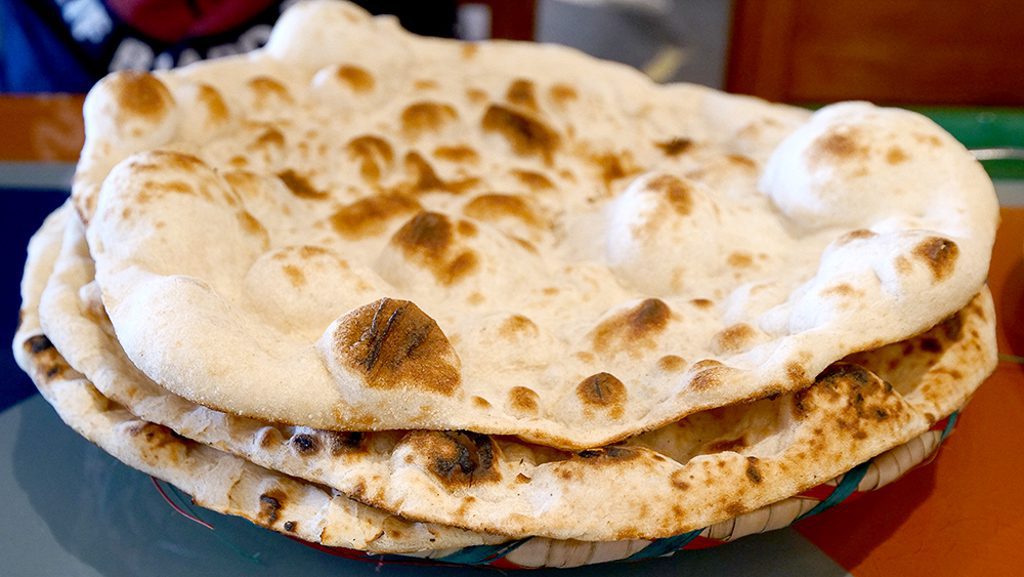
You also should not miss the mutton ribs with carrots and potatoes. They’re rich and fatty, and the meat is so tender, it slides right off the bones. Mutton is my favorite kind of meat, and the Kuwaiti people have perfected the art of preparing it! Finish off your sumptuous lunch with some thick, yogurt-like milk to cool off your mouth.

Kuwait may often get overlooked in favor of more popular and more luxurious Middle Eastern destinations, but it more than deserves some of the shine as well. Even though I only spent two short days in this desert oasis, it exceeded all of my expectations in terms of culture, attractions, and cuisine. The people there are some of the nicest and friendliest I’ve ever come across in my travels. They were always happy to teach me new things about their beautiful country or to just stop for a quick chat. I will remember the 48 hours I spent there for the rest of my life. Book a trip to Kuwait today to experience it all for yourself!
If you would like to visit Kuwait and check out the best things to see, do, and eat in the country, please contact my friends at Local Tour Kuwait!
NOTE: If you need to check the visa requirements of a particular country, click here. To apply for a visa, find up-to-date visa information for different countries, and calculate the cost of a particular visa, click here!
Counter
101 Countries • 1432 Cities